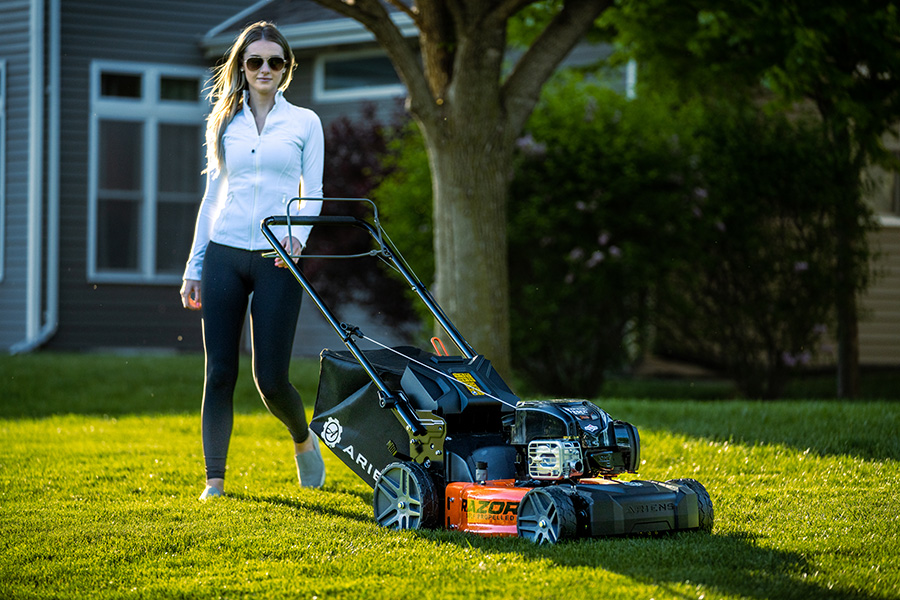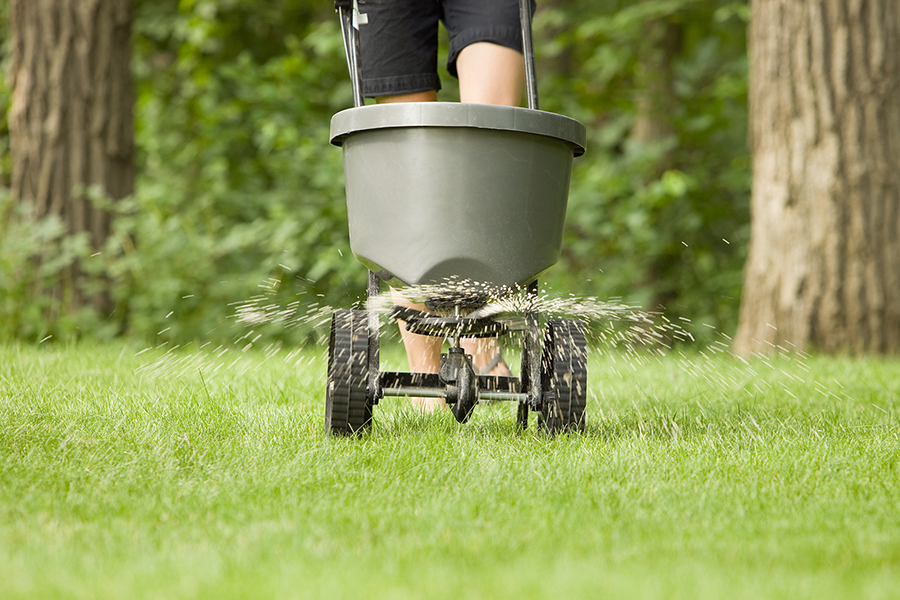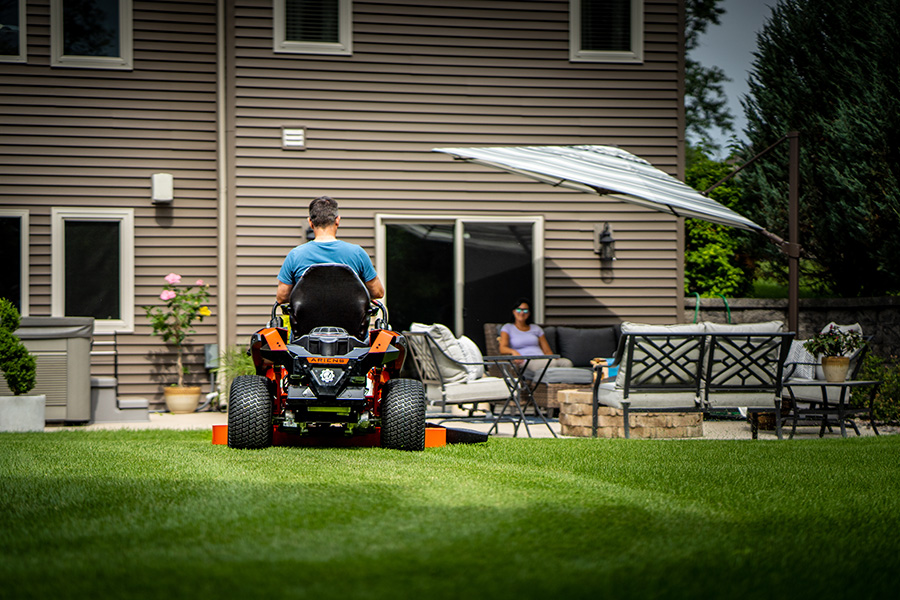Early Spring Lawn Care Tips
4/22/2025 11:29:27 AM
Your lawn is an entertainment space 
It takes a little more than a fresh cut with your walk-behind or zero-turn lawn mower to thoroughly enjoy the atmosphere your landscape can offer. Spring is a time of rejuvenation and new life, but it won't get there without a little help after the long, harsh winter. Winter leaves lawn weathered, in health and in looks, so it's time to give it some post-winter care so it can be enjoyed throughout the warm months.
Putting in a little work now and being attentive to details will reward you with a lush green lawn you can be proud of. Your lifestyle enjoys hosting backyard cookouts, bonfires and other social gatherings, and you'll want a presentable lawn when company visits.
1. How to prevent lawn disease and brown spots
Leaving snow in clumps can leave long-term lawn damage.
Snow that sits on a lawn for too long can form snow mold. If left undisturbed, the moisture harbored by melting snow can form a fungus known as snow mold and result in a lawn disease that affects most types of grass, leaving behind large brown patches of dead grass. As the snow starts melting, use a sturdy rake to spread the remaining snow across the lawn evenly so it melts faster and prevents mold from forming in pockets of melting snow. Additionally, thorough raking helps clear away thatch buildup on lawn soils.
2. Treating compacted soils after winter
Heavy snow that sits on lawns for long periods of time compacts the soil and leaves your lawn in sad shape. Rejuvenate it with aeration.
If you live in an area that receives little to light amounts of snow, you don't need to worry as much about compacted soils after winter. However, if your lawn sees a lot of foot traffic, snow clearing machinery, or just a lot snow, it's now compressed more than it was going into winter. Compressed soil is less able to absorb water, absorb nutrients and exchange carbon dioxide and oxygen with the atmosphere, leaving it less healthy and vibrant.
To help relieve compacted soils, improve its air exchange and water and nutrient absorption, lawns can be aerated. Aeration is usually done by a machine that pulls cores from the soil to decompress the soil and allow water, nutrients and air to reach the roots. As a result, homeowners are left with healthier roots that grow better and stronger.
Though experts typically recommend waiting until fall for lawn aeration, it's ok to aerate in the spring for lawns that are severely compacted. After an initial aeration, keep an eye out for moss buildup. This is an indication that it's time to aerate again.
3. Adding lawn nutrients after winter
Nutrition-deficient lawns don't grow well and won't have a bright green, look. After winter, fertilizer application may be necessary to fully bring back that lush appearance.
 Grass needs a relatively neutral pH (measurement on an acid-to-base scale) for it to grow healthy, but this varies depending on grass type. If you're not sure where your soil is on this scale, testing can be done by a local cooperative extension office. If the results show nutritional deficiencies, or has more of a basic pH, apply fertilizer. If a soil is too acidic, lime can be applied to a lawn to balance it and bring it closer to that neutral pH.
Grass needs a relatively neutral pH (measurement on an acid-to-base scale) for it to grow healthy, but this varies depending on grass type. If you're not sure where your soil is on this scale, testing can be done by a local cooperative extension office. If the results show nutritional deficiencies, or has more of a basic pH, apply fertilizer. If a soil is too acidic, lime can be applied to a lawn to balance it and bring it closer to that neutral pH.
When adding fertilizer or lime to lawns, use a high-quality spreader for even distribution in the application.
Early spring is a good time to apply a pre-emergent herbicide to combat a high volume of weed growth. Besides being unsightly, weeds can take over and affect grass growth, but applying an herbicide now will help prevent that interference and allow more grass growth. Many fertilizers come blended with pre-emergent herbicides, so to help the efficiency of your dollar, check to see which fertilizer brands and types offer two-in-one.
4. Planting new grass in bare spots
There's no rule against planting more grass. Sometimes the route to a thicker lawn is by adding more grass seed.
Sometimes bare sports are hard to avoid. As stated earlier, they can be a result of fungus, disease and soil compaction, but sometimes they're a result of other variables like pet droppings. Some patches may be a result of grass that has simply died off. Till those spots and apply grass seed and nitrogen fertilizer combination. Don't be afraid to overseed, either.
5. Get ready to mow
Time your first mow with the growth of your grass. It's especially important to wait to mow until grass reaches a certain height, otherwise you open the potential for lawn problems.
 Don't wait too long to start mowing again. There's no magic date to start cutting the grass, but it's best to wait for the grass to reach a certain height. This varies depending on grass type, but the right height for cutting is usually around 2.5 inches. Cutting grass when it's too short increases its susceptibility to disease, but waiting too long to mow can stunt grass growth because the taller blades will shade the shorter blades and prevent them from accessing sunlight.
Don't wait too long to start mowing again. There's no magic date to start cutting the grass, but it's best to wait for the grass to reach a certain height. This varies depending on grass type, but the right height for cutting is usually around 2.5 inches. Cutting grass when it's too short increases its susceptibility to disease, but waiting too long to mow can stunt grass growth because the taller blades will shade the shorter blades and prevent them from accessing sunlight.
While you're waiting to mow, prepare your lawn mower for the next season. This means completing maintenance like oil changes, belt changes, sharpening blades, etc. if they weren't completed at the end of the last season. Those looking for a walk-behind or zero-turn mower should do so as early as possible to take advantage of early season deals at and to get the models they want before dealership inventory is depleted.
Keep in mind these spring lawn care tips encompass throughout the entire season and to complete as many of these items as possible before summer. It's much easier and cheaper maintaining a lawn than having to replace one. For lawn mower replacement and maintenance parts and maintenance help, visit a local Ariens dealer or check the inventory at the Ariens parts store.
Katie Johnson is a gardening and landscape writer for LawnStarter Lawn Care. When she's not tending to her organic vegetable garden, she can be found exploring nature by bike or boat.